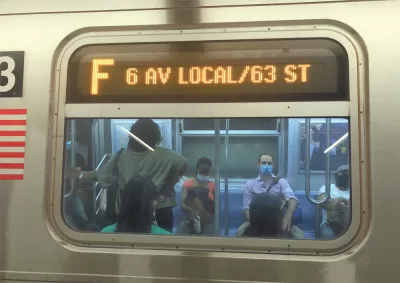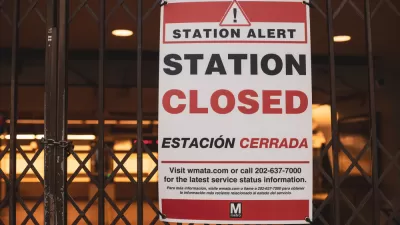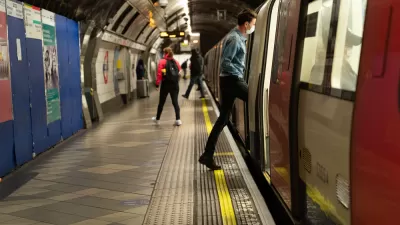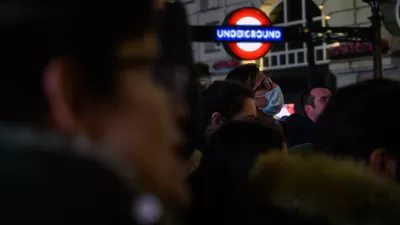Recent analysis by TransitCenter quantifies the effects of the pandemic for the 150 largest U.S. transit systems.

TransitCenter presents data on the operations of public transit agencies during the COVID-19 pandemic—finding ongoing evidence of sweeping service reductions in almost every part of the country. Some cuts have been deeper than others, however, as transit agencies have delt with declining ridership (and the farebox revenues that come along with riders)—whether due to disrupted commute patterns or stay-at-home orders—and the public health risks posed to operators.
TransitCenter analyzed data from National Transit Database monthly data to provide the following summariy of the state of public transit in the United States at the conclusion of the pandemic year, 2020.
Of the 150 largest transit agencies, about one in six were providing less than 75% of their pre-pandemic service hours in December 2020. Meanwhile, nearly a quarter were running between 90 and 100% of pre-pandemic service, and 27 agencies were running more service than they were before the pandemic as part of providing socially distanced transit.
Among those aggregated figures, TransitCenter also notes big differences between the largest agencies. While some have been able to restore most of the service cut in spring of 2020, some have struggled to restore service. The San Francisco Municipal Transportation Agency (SFMTA) has dealt with technical challenges restoring Muni Metro service, for example. The Maryland Transit Administration was operating just 66 percent of its pre-pandemic capacity in December, according to the article (after stopping short of cutting service even deeper). At the other end of the spectrum, Phoenix is operating more transit service than before the pandemic.
Breaking down the data by mode, TransitCenter reports that service has been cut most deeply for commuter rail—indicating one potential outcome of the long-term effects of fiscal stress and migration patterns of the pandemic.
FULL STORY: How Much Service Are Transit Agencies Running During the Pandemic?

Study: Maui’s Plan to Convert Vacation Rentals to Long-Term Housing Could Cause Nearly $1 Billion Economic Loss
The plan would reduce visitor accommodation by 25,% resulting in 1,900 jobs lost.

North Texas Transit Leaders Tout Benefits of TOD for Growing Region
At a summit focused on transit-oriented development, policymakers discussed how North Texas’ expanded light rail system can serve as a tool for economic growth.

Why Should We Subsidize Public Transportation?
Many public transit agencies face financial stress due to rising costs, declining fare revenue, and declining subsidies. Transit advocates must provide a strong business case for increasing public transit funding.

How to Make US Trains Faster
Changes to boarding platforms and a switch to electric trains could improve U.S. passenger rail service without the added cost of high-speed rail.

Columbia’s Revitalized ‘Loop’ Is a Hub for Local Entrepreneurs
A focus on small businesses is helping a commercial corridor in Columbia, Missouri thrive.

Invasive Insect Threatens Minnesota’s Ash Forests
The Emerald Ash Borer is a rapidly spreading invasive pest threatening Minnesota’s ash trees, and homeowners are encouraged to plant diverse replacement species, avoid moving ash firewood, and monitor for signs of infestation.
Urban Design for Planners 1: Software Tools
This six-course series explores essential urban design concepts using open source software and equips planners with the tools they need to participate fully in the urban design process.
Planning for Universal Design
Learn the tools for implementing Universal Design in planning regulations.
City of Santa Clarita
Ascent Environmental
Institute for Housing and Urban Development Studies (IHS)
City of Grandview
Harvard GSD Executive Education
Toledo-Lucas County Plan Commissions
Salt Lake City
NYU Wagner Graduate School of Public Service





























